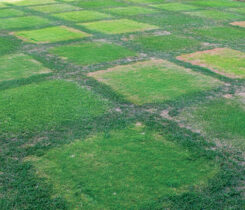Recovering from spring dead spot damage
Dennis Martin, Ph.D., is a professor of turfgrass science at Oklahoma State University and is well versed in spring dead spot through his more than 20 years of research and extension activities addressing the disease. Martin can be reached at dennis.martin@okstate.edu.
Q: Is there any way to predict during the winter or spring if the turf will suffer spring dead spot damage?
I am not aware of any method. While microscopic examination of plant parts can spot the fungus and damage on an individual plant basis, sampling on a large scale is impractical.
Q: What is the general biology of the spring dead spot fungus?
In fall, the fungus causing the disease invades stolons, rhizomes and lower portions of aerial shoots. Tissue not killed outright is predisposed to the effects of freezing temperatures. The fungus grows radially, resulting in circular patches of dead turf seen in spring.
Q: Outline the strategy you recommend to recover from spring dead spot damage.
When a superintendent first sees the symptoms at spring green-up, map the damaged areas through photography and in written form. Try to correlate damaged areas with suspect factors on the site. Usually damage is worse on north-facing slopes, highly susceptible varieties, fine-textured soils, heavily compacted areas and thatchy areas. Shade or sun seems to have little effect on occurrence.
Second, if a pre-emergence herbicide has not already been applied by the time spring dead spot symptoms are seen, a decision on product use is needed. With the exception of oxidiazon (example Ronstar), all other pre-emergence herbicides may damage new roots produced by stolons, slowing recovery in damaged areas. Use of other products depends on the extent of disease damage and how rapidly a superintendent wants the turf to recover, as well as tolerance of possible weed invasion.
Third, cultivation is often necessary. If compaction is present, an aggressive aerification program is a good idea. On the other hand, if the damaged area has a thatch build-up, aggressive verticutting is a good idea. Scout the damaged area, look at many turf cores and decide which cultivation technique fits best for the circumstances. With all cultivation techniques, golfer satisfaction has to be factored in to the decision.
Soil test and make decisions on phosphorus, potassium and pH additions based on soil test results. My experience is that bermudagrass grows best at a pH of 6.0 to 6.8, but some varieties can differ. Below a soil pH of 5.9 it’s advisable to lime to raise the pH. Most bermudagrasses tolerate soil pH values well into the upper 7s, so sulfur addition is generally not needed.
Apply 0.5 lbs. of soluble nitrogen per 1,000 sq. ft. in late March to early April in Oklahoma to damaged areas to promote early growth. After this application, monitor the weather and adjust as needed. After this early nitrogen application, continue with your normal nitrogen fertility program.
On our research plots and on some golf courses we have observed much less spring dead spot damage when the total yearly nitrogen application rate is 4.0 lbs. nitrogen per 1,000 sq. ft. or less. I recognize that this is a lean program and may not work in certain high traffic areas, but staying below 4.0 lbs. nitrogen per 1,000 sq. ft. per year is a good goal to pursue.
Q: Anything else you’d like to add?
Start the recovery program early. It gets warmer much earlier in the spring than ever before. Promote stolon growth early in the spring, induce the turf to recover and then shift to a holding pattern throughout the rest of the growing season.










